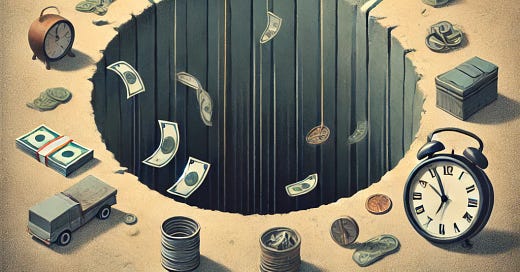Gardeners Need to Understand the Sunk Cost Fallacy
Gardening is all about making decisions, but we humans can be so irrational at times. Thankfully, by applying a little economics, we can waste less time, effort and money
Most people consider economics to be a little boring, and I would imagine that most gardeners are not thinking about economics when they are out in their gardens with the birds, bees and butterflies. But it would benefit them to dabble in it a little, because insofar as economics is about how to make choices in the face of a scarcity of resources, I think it has a lot to offer gardeners.
Gardening is all about making decisions, whether they are concerning what to plant, where to plant, how much to plant, or how much land to cultivate for planting, etc. As vegetable gardeners, each year we have a given set of goals, and we make decisions about how to allocate resources in our efforts to achieve those goals. For instance, one goal might be to grow a 4'x8' bed of carrots. There are a myriad of resources required to do that successfully, such as one's time, effort, the space required, the seeds, any soil amendments that might be needed, and any monetary costs associated with procuring those or other resources needed to grow the carrots. The decision to commit any of those resources to the growing of carrots comes at the cost of not being able to commit them elsewhere - and so one is forced to make choices in the face of a scarcity of resources, since none of us have unlimited time, space and money. These choices can be difficult for gardeners, and one can spend a ridiculous amount of time dithering over them - and still get it wrong in the end!
Economists have a way of cutting through the haze of decision-making by reducing tough choices down to their relative costs and benefits, such that an option can be chosen from among a given set of options, with some degree of confidence that it has the most likely chance of success. They are not always right - but that is because there are always unknowns that are hard to account for sometimes. Still, the discipline offers many useful tools for decision making - and one such tool is the identification of sunk costs, and how they can lead people to commit the sunk cost fallacy1.
A sunk cost is a commitment of resources that cannot be recovered. People commit the sunk cost fallacy when they persist in committing resources to a failing enterprise to which they have already invested in heavily, rather than cutting their losses. This can be due to undying optimism, stubbornness, an emotional attachment, or any other reason outside of the hard reality of recognizing that something is not working, and doesn’t look like it will work in the future.
A good example is a car that’s had thousands of dollars of repairs, but might only have a value of $500 in terms of what people might currently be willing to pay for it. The owner commits the sunk cost fallacy by holding out for a higher price while spending even more on repairs to keep it on the road, rather than simply letting it go for $500 and moving on. In effect, every dollar spent goes against the $500, because the car will never be worth more than $500 - and will be worth even less in the future. Another example is a restaurant that an owner has invested maybe hundreds of thousands of dollars to design, decorate, equip, market and brand - but for whatever reason - there are just not enough bums in the seats night after night to offset operational costs. At some point, the restaurant becomes a money pit, such that every day spent staffing and supplying it simply contributes to greater and greater debt and risk of bankruptcy.
As gardeners we do this all the time.
It can be a bed of vegetables that has been so heavily damaged by pests that it will not amount to anything - yet the gardener persists in waiting for things to turn around while the growing season slips away, rather then planting something more pest resistant to get a yield. It can be a perennial, like a raspberry bush, that is simply not the right variety for one’s growing conditions, so it never bears a good yield - yet the gardener tries every trick in the book year after year, instead of planting a better suited variety. It can be plant that just will not grow well in one’s growing zone, yet the gardener tries to grow it anyway, year after year, instead of just giving up and growing something else.
The important thing to realize in order to avoid the sunk cost fallacy is that all your previous efforts and expenditures DO NOT MATTER ANYMORE. That time and money are gone, and the only value they now have to offer is whatever lessons you learned from the failure(s) you experienced while trying to grow those things.
What DOES MATTER is achieving a yield by the end of the growing season, or in future growing seasons in the case of perennials, and putting a plan in place that will result in future success - and acting on it right away.
So much of gardening is about action. Sure, thought and contemplation are important, and necessary - but once the gardening season is in play, action is what matters. Similarly, when the season is over, and winter is approaching, it is time to act on those major changes you have been thinking about for years and make them happen, so that things can be better next season. By being aware of when you are committing the sunk cost fallacy, you can more quickly determine when a change is needed, and have the time to act before prolonged indecision costs you another growing season.
Final Thoughts
For some, this highly rational approach to decision-making might feel like it will take some of the magic and creativity out of gardening - but I would argue that is not the case. Rather, it takes one of the most difficult aspects of gardening (decision-making) and makes it easier by giving you perspective, and the ability look beyond your emotional attachment to things. This is important because a bad gardening decision, or indecision, can affect an entire season, and one must wait a whole year to try something else. Don’t worry, there will still be plenty of magic and creativity in your gardening experience - just less time and effort wasted.
FREE SHIPPING FROM VESEYS SEEDS
Use my coupon code “GAVS24” to get free shipping from Veseys Seeds. At least one pack of seeds must be included in the order. Free shipping is not applicable on surcharges on larger items. Promo code is valid until November 30, 2024.
Here’s a video where I remove a set of raspberry bushes because they are not working:
A fallacy is a an error in reasoning that weakens an argument. Humans are prone to irrationality, so there are many types of fallacies. Here’s a good list of many of them - I keep a list of the most common ones on the wall next to my desk, just to stay humble.






I appreciate the range and depth that you bring to topics Greg, it is apparent that you’re always looking to learn new things and see things from different angles.